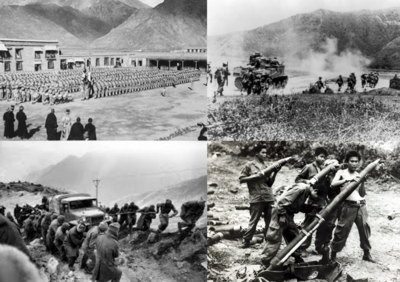Trucial Wars
This article is incomplete because it is pending further input from participants, or it is a work-in-progress by one author. Please comment on this article's talk page to share your input, comments and questions. Note: To contribute to this article, you may need to seek help from the author(s) of this page. |
| Trucial Wars | ||||||||
|---|---|---|---|---|---|---|---|---|
| Part of the Decolonisation of Southeast Coius | ||||||||
 (clockwise from top)
| ||||||||
| ||||||||
| Belligerents | ||||||||
|
Supported by: |
Separatist Alliance | ||||||
| Casualties and losses | ||||||||
|
375,000–510,000 killed 2.1 million excess deaths from famine, disease, exposure | ||||||||
The Trucial Wars were a series of multi-sided civil conflicts, interspersed by numerous ceasefires and realignments, fought between opposing factions of the Zomi Confederal State, separatist nationalist movements, and socialist revolutionary groups from 1958 to 1970.
The fighting was instigated by a breakdown in union negotiations between the Princely States of the former Trucial Territory of the Northern Chieftaincies. As part of its programme of rapid decolonisation the Weranian Tripartite Government had dissolved its treaties with all Zomi rulers in 1952, and the immediate Shangean annexation of the northwestern Hkakari Chieftaincy had forced the hasty establishment of a provisional Pan-Zomi government with broad emergency powers. The resultant Zomi Confederal State was thus a fragile and insubstantial arrangement that left the finer points of political unification undetermined. Instead of a federation of equal partners, the lesser Princely States and Chieftaincies found themselves thrust into a military alliance in which the respective strength of clan militias was the only guarantor of influence. Minority groups - and the long marginalised Oegun majority - were totally disenfranchised, provided nothing by the provisional government but vague promises of elections once the Shangean threat had subsided. Between 1952 and 1958, socialist and separatist movements swelled in strength, and in secret, the Princes of Ðàku and Kyagaw negotiated terms of partition with the Zomi Section of the Workers' International, in exchange for an end to agitation in their own territories. In diverse Zomia, socialism had taken on an ethnic dimension, and the Zomi socialist leadership was in effect the political arm of the dispossessed Ryo minority, hostile towards the privileged Hsan-Lue that had most benefited from the colonial treaties. As there were no Ryo populations in the Ðàku or Kyagaw regions, an agreement was able to be reached.
On the 30th July 1958, the States of Ðàku and Kyagaw declared their secession from the Confederal Zomi State. In response, loyalist militias were thrown into rushed punitive expeditions, characterised more by looting and massacres than actual fighting, leaving pro-government forces widely dispersed, disorganised and vulnerable to encirclement. The 11th June socialist uprising, thoroughly planned by Lavanan and Dezevauni military analysts, and well-supplied by smugglers operating for years on the poorly patrolled Lavanan border, rapidly routed or destroyed the Confederal expeditions. The newly declared People's Republican Army of the United Zomi Councils swept over most of the Zomi highlands virtually unopposed, and the UZC would constitute the de facto government of Zomia until its collapse in the late 1960s. Within days of the Confederal defeat, nationalist unrest in the Chanwan-majority West, the Oegun-majority North and the Kiau-majority Southeast had exploded into full-blown insurgencies, which, in various combinations, would fight both with and against the PRA over the following years, as would the independent Chanwan National Socialist movement, which attempted unsuccessfully to bring about a permanent alliance between the Separatist forces and the UZC.
Although the total defeat of the Zomi Confederal State seemed inevitable to foreign observers in the late 1950s, various pro-Confederal militias emerged in the early 60s in resistance to UZC rule, most notably the Hsan Salvation Front, an ethnic Lue militant Badi-Zohist group which swore loyalty to the Paramountcy-in-Exile, and the United Army of the Liberation, a multi-ethnic alliance of Tribal Protection Units and mutinying PRA labour battalions. Devastated by a deliberate famine created through agricultural collectivisation and mass displacement, intended by the UZC's Ryo leadership to decimate their ethnic enemies, the remnants of the Kiau separatist movement agreed to a ceasefire with the HSF in 1961, and eventually an alliance with the Confederal Government in 1964. Betrayed by their socialist allies in 1960, the surviving forces of the secessionist Ðàkan Princedom rose up in 1965. The UZC would in turn be betrayed by the Chanwan National Socialist Front in 1966, in return for concessions of rights and autonomous regions by the Confederal government. The UZC gradually collapsed into ethnic infighting and factionalism, as pro-Confederal forces were bolstered by increasing Kuthinan and even Shangean support. The Confederal-Royalist Coalition achieved final victory in March 1970, when the capital of Cireram was retaken and the Paramountcy restored as the Prince Presidency.
The new constitution of the 17th March, rigorously negotiated over the past decade, established the present elective and absolute monarchy, mandated democratic elections to a consultative body, and demarcated almost a hundred Autonomous Tribal Territories and Federal Chieftaincies. The Kasine-speaking Kiau State was granted a unique status as a semi-autonomous constitutional monarchy within the Union, in line with concessions made to the All-Kiau Free Army to secure a wartime alliance.